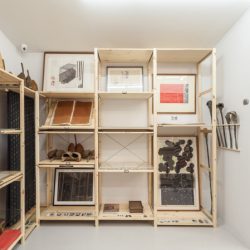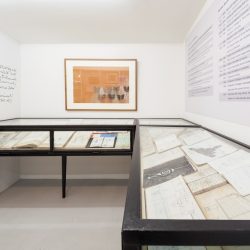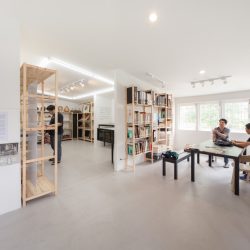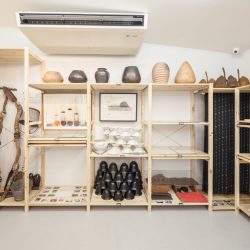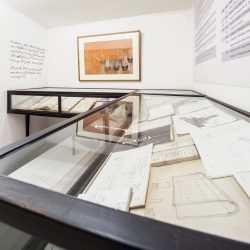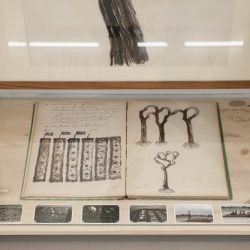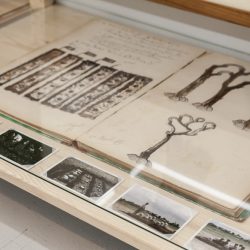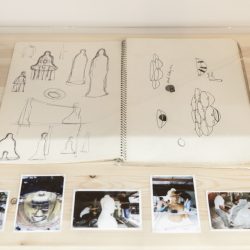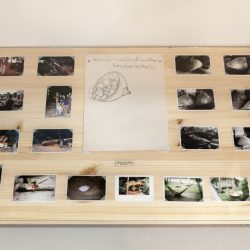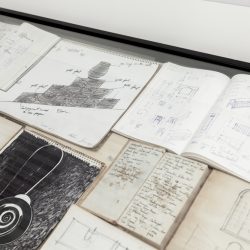MONTIEN BOONMA WOULD HAVE BEEN 64 YEARS OLD THIS YEAR IF HE WERE HERE, LEAVING HIS ARCHIVE BEHIND IN A SPACE OF 40 SQ. M
TEXT: TUNYAPORN HONGTONG
PHOTO: KETSIREE WONGWAN
(For English, please scroll down)
มณเฑียร บุญมา เสียชีวิตเมื่อปี พ.ศ. 2543 แต่เพราะผลงานศิลปะมีคุณค่าจำนวนมากที่เขาได้สร้างสรรค์ไว้ ทำให้ตลอด 17 ปี ที่ผ่านมา เราจึงยังคงได้เห็นชื่อของเขาปรากฏร่วมอยู่ในหลายต่อหลายนิทรรศการทั่วโลก รวมทั้งยังมีกิจกรรมทางศิลปะที่เกี่ยวข้องกับมณเฑียรให้เห็นอย่างต่อเนื่อง ล่าสุด ในปีที่หากมณเฑียรยังมีชีวิตอยู่ เขาจะมีอายุครบ 64 ปี ลูกชายของเขา จุมพงษ์ บุญมา ก็ได้เปิดตัว Montien Atelier สถานที่จัดเก็บผลงานสเก็ตช์ ภาพถ่าย สมุดบันทึก จดหมาย หนังสือ ชิ้นส่วนจากผลงาน ฯลฯ ที่เกี่ยวข้องกับการทำงานศิลปะของมณเฑียร
Montien Atelier ตั้งอยู่บนชั้นสองของบ้านที่มณเฑียรเคยอาศัยอยู่ในซอยงามวงศ์วาน 25 นนทบุรี โดยหลังจากที่บ้านถูกปล่อยทิ้งร้างอยู่หลายปี จุมพงษ์และเครือญาติก็ตัดสินใจที่จะปรับปรุงตัวบ้าน เปิดชั้นล่างเป็นร้านอาหาร-กาแฟ ด้านหน้าเป็นพื้นที่สำหรับเวิร์กช็อป และในความตั้งใจแรกนั้นต้องการทำชั้นสองให้เป็นแกลเลอรี่

“แต่ตอนที่เรารื้อบ้าน เราเจอของของคุณพ่อเยอะมาก ทั้งสเก็ตช์ รูปถ่าย หรือ ชิ้นส่วนจากอินสตอเลชั่นก็เลยคิดกันว่าเราจะทำยังไงกับของพวกนี้ดี” จุมพงษ์เล่าถึงที่มา “นี่คือปัญหาหนึ่ง ส่วนอีกปัญหาก็คือ พื้นที่บนชั้นสองค่อนข้างเล็กแค่เราเอาสเก็ตช์มาใส่กรอบก็เต็มพื้นที่แล้ว พอดีช่วงนั้น ผมได้ขึ้นไปเชียงใหม่แล้วเจอพี่ฤกษ์ฤทธิ์ (ฤกษ์ฤทธิ์ ตีระวนิช) แกก็เลยแนะนำให้ทำเป็น archive แทนที่จะเป็นแกลเลอรี่ และเมื่อมาปรึกษากับพี่ตาล (โสมสุดา เปี่ยมสัมฤทธิ์ – ภัณฑารักษ์จากหอศิลป์บ้านจิม ทอมป์สัน ที่เคยร่วมทีมภัณฑารักษ์ในนิทรรศการ “ตายก่อนดับ การกลับมาของ มณเฑียร บุญมา” และ “Montien Boonma: Unbuilt/Rare Works”) ก็ได้รับข้อเสนอว่าเราน่าจะทำเป็น storage เรียงเรื่องราวทั้งหมดตาม timeline เราก็เลยเริ่มต้นทำเป็น storage แทน เอาทุกอย่างที่เจอมาจัดเรียงเป็นหมวดหมู่และทำเป็นดิจิทัลเก็บไว้ด้วย” นอกจากทีมงานหลักๆ จะมีโสมสุดาแล้ว ก็ยังได้อภิสิทธิ์ หนองบัว ลูกศิษย์และผู้ช่วยคนสำคัญของมณเฑียรมาเป็นที่ปรึกษาโครงการ และ Montien Atelier ก็ได้เงินทุนสนับสนุนส่วนหนึ่งจาก Gallery VER ของฤกษ์ฤทธิ์

storage ที่โสมสุดาว่าไว้ แน่นอนว่าไม่ใช่แกลเลอรี่ที่จัดแสดงผลงานศิลปะแบบที่จุมพงษ์มองภาพไว้แต่แรก ส่วนหนึ่งเพราะข้อจำกัดทางพื้นที่ที่มีขนาดเพียง 40 กว่าตารางเมตรเท่านั้น ในขณะที่ผลงานของมณเฑียรแต่ละชิ้น โดยเฉพาะอินสตอเลชั่นมีขนาดใหญ่มาก ไม่นับที่งานหลายชิ้นก็ถูกจัดแสดงจนเห็นกันจนชินตาไปแล้ว แต่ storage ในความหมายของโสมสุดาคือสถานที่จัดเก็บองค์ความรู้ต่างๆ ที่เกี่ยวข้องกับศิลปะของมณเฑียร เพื่อให้ผู้ที่สนใจสามารถเข้ามาค้นหาและทำความรู้จักการทำงานของศิลปิน ดังนั้นในการคัดเลือกชิ้นงานแต่ละชิ้นมาจัดแสดงจึงเน้นชิ้นงานที่คนมักไม่ค่อยได้เห็น รวมทั้งเป็นชิ้นที่สามารถแสดงให้ผู้ชมได้เห็นวิธีคิด กระบวนการทดลอง และการทำงานของมณเฑียร “ในผลงานแต่ละชิ้น อาจารย์มณเฑียรมักจะรีเสิร์ชและทดลองอะไรหลายอย่าง อาจารย์เป็นศิลปินทดลอง เห็นได้จากสเก็ตช์ ภาพถ่ายที่อาจารย์ถ่ายเก็บไว้ระหว่างการทำงาน หรือบางชิ้นก็มีโมเดลด้วย อย่างเช่นวิธีการเรียงอิฐในงานอินสตอเลชั่นที่เรารู้มาว่าอาจารย์สนใจในเรื่องภูมิปัญญาท้องถิ่น และอิฐที่เรานำมาจัดแสดงนี้ก็ไม่ได้ไปซื้อใหม่ แต่เป็นอิฐที่เราเจออยู่ในบ้านของอาจารย์ ซึ่งเราก็เดาว่าอาจารย์ไปซื้อมาเพื่อทดลองวางเรียงกันก่อนที่จะติดตั้งงาน เราก็เลยอยากให้คนมาเห็นว่าก่อนที่จะออกมาเป็นชิ้นงานที่สมบูรณ์อย่างที่เราเห็นๆ กันนั้น กระบวนการคิดและทำงานของอาจารย์เป็นยังไง” โสมสุดาเล่า พร้อมบอกว่าชิ้นงานทั้งหมดที่นำมาจัดแสดงใน Montien Atelier นี้เป็นเพียง 25% ของข้าวของทั้งหมดที่พวกเขาเจอในบ้านหลังนี้เท่านั้น ส่วนหนึ่งต้องขอบคุณมณเฑียรที่บันทึกกระบวนการคิดและทำงานของตนเองไว้อย่างเป็นระเบียบทุกขั้นตอน “หรืออย่างรูปถ่ายจากสมัยที่อาจารย์ยังเรียนอยู่ที่ศิลปากรหรืออาจจะคาบเกี่ยวไปจนสมัยที่เรียนเพาะช่าง เราก็จะเห็นภาพถ่ายใน compose แปลกๆ และเทคนิคการเพนต์ลงไปบนภาพถ่ายเลย ซึ่งมันก็แสดงให้เห็นว่าอาจารย์สนใจงานคอลลาจที่หลุดออกไปจากงานสองมิติมาตั้งแต่ตอนนั้น จนในที่สุดมันก็ค่อยๆ พัฒนาจนกลายเป็นงานอินสตอเลชั่นอย่างที่เรารู้จักกัน”

การจัดเรียงชิ้นงานต่างๆ ใน storage ใช้วิธีเรียงไปตามลำดับเวลา โดยเริ่มจากสมัยที่มณเฑียรยังเป็นนักศึกษาคณะจิตรกรรมมหาวิทยาลัยศิลปากร สมัยที่ทำงานสีน้ำกับกลุ่ม White Group ช่วงที่ศึกษาอยู่ที่ฝรั่งเศส กลับมาสอนที่มหาวิทยาลัยเชียงใหม่ ช่วงที่ภรรยาของมณเฑียรล้มป่วยด้วยโรคมะเร็งเต้านม ไปจนถึงช่วงสุดท้ายในการทำงานของมณเฑียรก่อนจะเสียชีวิตด้วยโรคมะเร็งปอด โดยในแต่ละช่วงเวลานั้น คิวเรเตอร์จะเน้นให้เห็นถึงจุดเปลี่ยนต่างๆ ในการทำงานศิลปะของมณเฑียร เช่น ช่วงที่มณเฑียรเริ่มหันมาใช้ found object ที่มีความหมายในตัวมันเองแทนวัสดุราคาแพง ด้วยอิทธิพลส่วนหนึ่งที่ได้มาจาก Arte Povera ในอิตาลี บวกกับข้อจำกัดทางรายได้ของข้าราชการ ความสนใจในเรื่องราวของสังคมในช่วงรอยต่อระหว่างสังคม เกษตรกรรมและอุตสาหกรรม การเปลี่ยนมาพูดเรื่องศาสนามากขึ้นหลังจากการล้มป่วยของภรรยา ซึ่งในช่วงเดียวกันนี้เอง มณเฑียรก็เริ่มหันมาใช้วัสดุหนักในศิลปะ รวมทั้งการติดตั้งจัดวางชิ้นงานที่เล่นกับประสาทสัมผัสและประสบการณ์ของผู้ชม ทั้งในเรื่องของกลิ่น เสียง และความรู้สึกถึงความไม่มั่นคง ซึ่งการเลือกชิ้นงานที่เห็นจุดเปลี่ยนที่สำคัญ รวมทั้งการจัดวาง storage เรียงไปตามระยะเวลาดังกล่าวก็ดูจะทำให้ผู้ชมเข้าใจการทำงานศิลปะของมณเฑียรได้ดียิ่งขึ้น โดยเฉพาะว่าศิลปะและชีวิตของเขาแทบจะกลมกลืนเป็นเนื้อเดียวกัน

งานเพียงชิ้นเดียวใน Montien Atelier ที่ไม่ใช่ผลงานของมณเฑียร คือ House of Hope (2013) โดย นาวิน ลาวัลย์ชัยกุล ที่เป็นเพนต์ติ้งหนึ่งชิ้นบวกกับวิดีโออีกหนึ่งชิ้น แต่ความเกี่ยวเนื่องของงานชิ้นนี้กับมณเฑียรก็คือ นาวิน ผู้เป็นอีกหนึ่งลูกศิษย์และผู้ช่วยติดตั้งงานคนสำคัญของมณเฑียร ได้เดินทางมาที่บ้านหลังนี้และเจอกับเฟรมผ้าใบที่มณเฑียรเคยเตรียมไว้ให้กับจุมพงษ์ใช้เพนต์รูป นาวินจึงวัดขนาดเฟรมนั้นไปและนำไปใช้เป็นขนาดของเพนต์ติ้งรูปครอบครัวของมณเฑียรจากอดีตถึงปัจจุบัน นอกจากนั้น นาวินก็ยังจัดทำวิดีโอที่บันทึกภาพภายในบ้านหลังนั้น โดยมีแบ็คกราวน์เป็นเสียงเปียโนบรรเลงเพลง Funeral March ของ Chopin ที่ภรรยาของมณเฑียรเคยเล่นที่บ้านและเป็นเพลงโปรดของมณเฑียร
“ที่เรารวมงานชิ้นนี้ไว้ในนี้ด้วยก็เพราะเราอยากให้ผู้ชมได้เห็นบรรยากาศของบ้านก่อนที่จะรีโนเวท” โสมสุดากล่าวถึงเหตุผลเพียงสั้นๆ ซึ่งนั่นก็ดูจะเป็นอีกครั้งที่ทีมคิวเรเตอร์ได้เอาชนะข้อจำกัดทางเรื่องพื้นที่ด้วยการเลือกชิ้นงานที่อัดแน่นไปด้วยเรื่องราวและความหมายเพียงไม่กี่ชิ้นมาเล่าเรื่องได้อย่างดี

Montien Boonma passed away in 2000 but his artistic legacy accumulated throughout the 17 years of his glorious career, earning him international recognition with exhibitions in countries across the world including activities held as an homage to one of Thailand’s most revered artists. Recently, in 2017, the year that Montien would have celebrated his 64th birthday if it weren’t for his untimely death, his only son, Jumphol Boonma, officially opened ‘Montien Atelier,’ a space that brings together works, sketches, photographs, notebooks, letters, books and bits and pieces from his artworks, etc., essentially everything related to Montien’s artistic opus.

Montien Atelier occupies the second-floor space of the house that Montien once lived in. The residence is located on the street called Soi Ngamwongwan 25 in Nonthaburi province. After years of being left unattended, the house was renovated following the idea of Jumphol and close family members with the ground floor functioning as a restaurant/coffee house. The space at the front of the house is used to host workshops while the second floor has been transformed into a gallery space, following the project owner’s initial intentions.
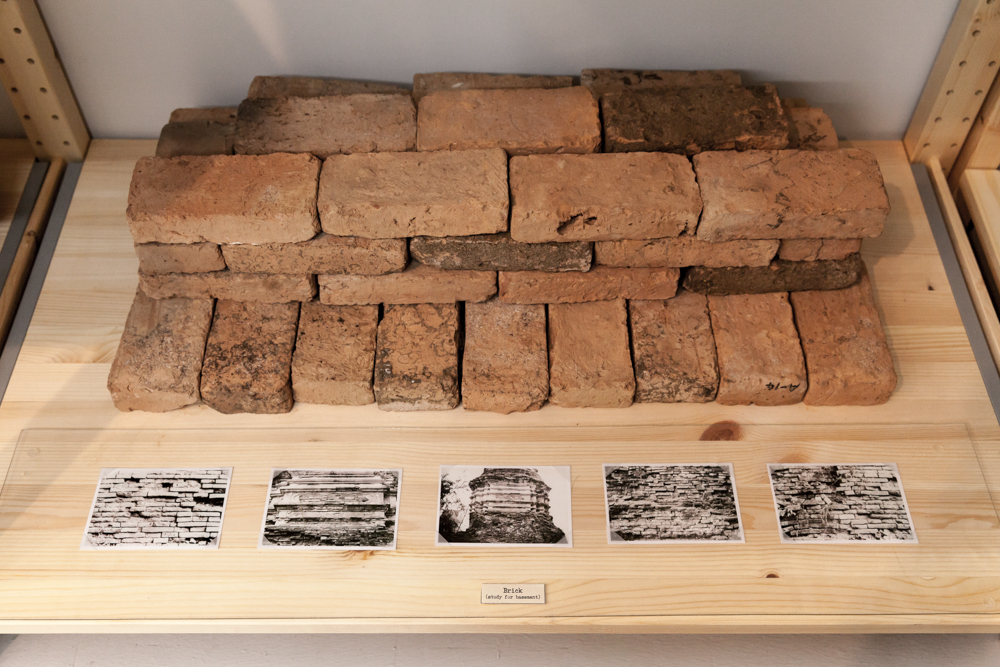
“When we went through dad’s stuff kept at the house, we came across a great number of items such as sketches, photographs, or parts of his installation pieces. The discovery got us thinking about what we could do with all these objects that we found,” said Jumphol of the origin of the project. “That was one problem. Another problem was the rather confined space on the house’s second floor, which could barely hold the sketches that we had, especially if they were framed. It just so very happened that I went to Chiang Mai and had a chance to meet Rirkrit (Rirkrit Tiravanija), and he suggested that we should create an archive instead of a gallery. We discussed this idea with Tarn (Somsuda Paimsamrit – a curator of Jim Thompson Gallery who co-curated “Montien Boonma: Unbuilt/Rare Works”), and she proposed that we should create storage where father’s story could be told in a timeline. So we decided to go with that idea and put everything we found into categories with an additional digital archive.” Apart from Somsuda, the key members behind the project included Aphisit Nongbua, Montien’s important protégé and assistant who joined the team as the project’s consultant with part of the funding for Montien Atelier coming from Rirkrit’s VER Gallery.
‘Storage’ as Somsuda calls it, is not a gallery space that exhibits the artist’s works like Jumphol initially intended, partly because the limited space of only around 40 square meters can barely accommodate the large scale of Montien’s artworks (particularly the installation pieces and not including the number of works that have been regularly exhibited). Storage, according to Somsuda, is a space that brings together Montien’s artistic repertoire for interested individuals to learn more about the artist’s working process. The selection of exhibited objects highlights the display of works that are rarely shown and embody the thought and working process as well as artistic experiments of Montien Boonma.
“From every piece of his work, we can see how Professor Montien was a keen researcher with an interest in and study of so many different things. He was a true experimental artist as one can see from the sketches and photographs or even the models he created and collected during the development of his works. For instance, the configuration of the bricks in one of his installations was the result of his interest in local wisdoms. The exhibited bricks were taken from the items left at his house and from our speculation these bricks were used as an experiment for one of his installation pieces. The idea is to show how the works were developed, and what his thought process and working methods were,” Somsuda told art4d before further explaining how all the exhibited works in Montien Atelier mark only 25% of all the items found in the house, thanks to Montien’s organized documentation. “The photographs range from when he was a student at Silpakorn University all the way to his Poh Chang College years. We got a hold of some photographs with unusual compositions and paintings done directly on the photographs. They are proof of his interest in collage and attempt to break away from two dimensional forms since he was young as well as how such interest might have been developed into the installation pieces that we all know today.”
The order of the presentation of the exhibited works in the storage is done chronologically from the time when Montien was an art student at the Faculty of Painting of Silpakorn University, to when he was working primarily in watercolor with White Group during his post-college years in France, before he returned home and worked as a professor at Chiang Mai University when his wife was diagnosed with breast cancer and the final years of his life before he passed away from lung cancer. In each period, presented are turning points in Montien’s artistic career such as the time when he began using found objects instead of pricey materials, a decision speculated to be influenced by Italy’s Arte Povera movement. With financial limitations, considering the fact that he was working only as a governmental officer, and his interest in social issues during the transitional period that changed Thailand from an agricultural to an industrial country, his artistic consciousness became more engaged in religious issues after the sickness of his wife. It was a time when Montien became more oriented toward the use of hard objects as well as installations that played with viewers’ sensory perceptions and experiences such as smell, sound and sense of insecurity. The selected works encapsulate these turning points while the chronological arrangement of the storage allows for viewers to have a better understanding of Montien’s artistic process and the indivisibility between his life and art.
House of Hope (2013) by Navin Rawanchaikul is the only piece of art in the space that is not Montien’s. Comprised of a painting and a work of video art, this tributary piece’s connection with Montien is its creator, Navin, who was one of Montien’s closest assistants and helped the master in the installation of his works. Navin visited the house and found a canvas Montien had prepared for Jumphol to work on a painting. After measuring the frame, Navin painted a family portrait of the same size, depicting the assemblage of the family’s memories from past to present. The video documents the images of the house with the sound of a piano playing Chopin’s Funeral March in the background. The song, which was one of Montien’s favorites, was regularly played by Montien’s wife when they lived in the house together.
“We included this particular piece of work because we want the viewers to see what the house was like before it was renovated,” Somsuda succinctly explained of the reason behind the decision, which seems to be another successful attempt by the curatorial team to overcome the project’s spatial limitations by choosing only the works that are meaningful to the story they wish to tell.



